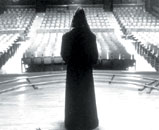TURBULENT
The following essay, by director Atom Egoyan, was commissioned by the Musée D’Art Contemporain in Montreal for a catalogue accompanying the first major museum solo exhibition of the work of Shirin Neshat. The exhibition, which runs through January 13, includes six video installations and sixteen related photographs. It is scheduled to tour to the Walker Art Center, Minneapolis, June 15 - September 8, 2002; Miami Art Museum, March 21 - June 1, 2003; and the Contemporary Arts Museum, Houston, September 6 - November 2, 2003.
 |  |  |
| Turbulent (1998) | ||
IT IS APRIL 2001. In a few weeks, I will commence the shooting of my tenth feature film. Ararat has consumed me for a long time. I have spent the past two years working on the script, approaching my actors, and assembling all the pieces needed to make a dramatic feature. My mind is completely full of the images I will commit to film for the next four months. So why did I need to find the time to write these words?
The answer is simple. These words are written in thanks. They are written to an artist, Shirin Neshat, who has produced a work which has completely inspired me. In these crucial weeks before I start any shoot, I always revisit the great films which have nourished me. I re-watch these films with hunger. I need to replenish myself. I must sharpen my senses so that I will be operating on set with absolute concentration, with all my creative powers open and as generous as possible to my actors and collaborators.
Yet there has been something different this time. As I watch my favorite films, they don’t seem as special anymore. I don’t find myself as moved by their mysteries and hidden meanings. I become impatient. What is it about these masterpieces — the great works of international art cinema — that has changed? Nothing, of course. These astonishing films have lost none of their brilliance. What I find difficult to imagine now is the culture in which these films were made.
In the past few years, filmmaking has become commonplace. What used to be a rarified activity is now available to anyone with a digital camera and a computer. For the first time, it is possible to imagine that a home-made digital image can be shown in commercial cinemas and mainstream televisions. There is nothing special about the practice of making motion pictures. It has become, in the years since home video has been widely available, a completely democratized activity.
The culture that sustained the great masters of art cinema was inherently suspicious of image production. You can feel it when you watch the films. The images are given time to be reflected upon. The artists felt that they had the power of magic; the ability to take time to transform time. Contemporary films aren’t expected to do that. When they do, they seem old-fashioned and lethargic.
When I was asked to write this text, I was feeling despondent. I felt that my purpose for making films had become confused by a culture where image-making had lost its sense of rarity. I was desperate to find something which would give me a sense that what I was about to do — contribute yet more images to an image-saturated culture — might have purpose and meaning. Then I experienced Shirin Neshat’s Turbulent.
I entered a dark room. On one wall, a singer delivers a passionate love song to a group of men. He is faced away from his audience, secure that his performance will be accepted and adored from whatever position he chooses to take. This is his cultural privilege. He is a man, surrounded by men. On the opposite wall, a woman in a black chador stands silently throughout his song. She faces an empty auditorium. This is the position she has no choice but to take. Her society has imposed it on her. She is expected to face the empty seats. To comply with the strictures of her state, she can’t dance to the music, show the shape of her body, or uncover her head. Above all, she cannot sing in public. This might inflame the passions of the male viewers. It might break their concentration on their beloved singer, the man who is so confident of his audience’s devotion that he can turn his back to them.
Then something stunning happens. As the male singer finishes his song, he turns around to bow to his audience. Suddenly, a mysterious sound beckons him away from the appreciative, applauding men and he again turns around to face the lens. At this moment, on the opposite screen, the camera begins a sinuous, sensual track towards the hidden female singer. As the camera circles around this figure, we hear an impassioned wordless song composed of supernatural breaths and ecstatic cries — an amazing symphony of unbridled, primal emotion.
As the camera continues to swirl around this astounding monument of passion, one is immediately struck by the contrast between the male singer’s descriptive lyrics (his song is based on a text by Jalal al-Din Rumi), and the completely abstract sound poem that flows from the woman’s lips. Is the viewer meant to appraise which performance is more authentic? What is so provocative about Turbulent is that no judgement can be passed without a thorough examination of the context these respective singers are placed in. The male performance is socially sanctioned and realistic. The woman’s performance is outlawed and exists only as a dream.
While much has been written about the overtly political nature of Neshat’s work, Turbulent is also a groundbreaking piece of filmed drama. The male and female narratives are simultaneously opposed and complimentary. The viewer, placed between the two screens, cannot physically absorb both at the same time. No vantage point in the installation allows the audience the privileged position of omniscience provided in a conventional cinema or single-monitor viewing. The continuous stream of angles and compositions which comprise a traditional film or television experience are challenged by this form which situates the viewer as the effective editor of their own experience of the work. It would be possible, for example, to watch the male figure as the woman’s soulful song is heard. Depending on which way one observes the piece, there are an infinite number of ways that Turbulent may be constructed.
In this way, the piece is a hidden discourse that can only become fully articulated as one determines to what extent they will actively mediate the work. As Nathalie Leleu points out, the viewer “actually becomes one of the actors, armed with his or her own culture, but assailed by the clues concealed in the visual device.”1 Almost a quarter of a century after the Iranian revolution, Neshat is clearly intending a sharp critique of the patriarchal, fundamentalist society that was once her home. The power of the work, however, is ultimately held in its ability to question more universal issues relating to our responsibility to navigate through the sea of possible worlds that Turbulent concurrently presents and withholds.
It is precisely this unique quality of the work — its ability to be at once open and generous and yet so completely impenetrable — that I find so nourishing in these weeks before I begin to shoot my next film. In imagining the months of production and editing ahead, the primary task of the director, as visual strategist of the film, is to place the shots and angles that will best serve the story. There is a certain burden in the thought that in a year from now the film will be “finished”. Its sounds and images will be fixed. There will be shockingly little room for indeterminacy. Even in the most ideal of circumstances — a film that is genuinely open to interpretation with a viewer who is open to exploration — there is a fixed nature to the foundation of this negotiation. Compare this to the endless possibilities inherent in a piece of visual sculpture such as Turbulent. There is a visceral shock to the physical nature of its drama. Is the male singer remembering this woman? Is she a figment of his imagination, or is he a figment of hers? Is she the possible subject of his song? Does he feel guilt? Shame? Wonder? Fear?
In one devastating moment, near the end of the piece, as the woman finishes her song, the man’s image becomes frozen. The projected video image is stalled, and the freeze-frame on this face suddenly transports him into the realm of the abstract and unreal. On the opposite screen, finished with her transcendent performance, the woman’s “real-time” image is allowed to linger. She takes breaths. She is given life.
Neshat was raised in a culture where the image was regarded with suspicion and contempt, but now situates herself in a culture where the image is omnipresent and completely de-consecrated. Her work presents a unique balance between a world that is very old and one that is so new that it compulsively re-invents itself with alarming speed and recklessness. Her work is thus simultaneously alienating and transcendent, distant yet almost unbearably close. In forcing the viewer to choose sides without an overt moral compass, Turbulent miraculously creates its own sense of a spontaneous and highly volatile culture.
1. Nathalie Leleu, "Shirin Neshat: The Image Dispute," trans. from the French by Stephen Wright, Parachute, No. 100, “The Idea of Community > 01,” Oct., Nov., Dec. 2001, p. 85.
[Back to text]
VOD CALENDAR


 See the VOD Calendar →
See the VOD Calendar →


